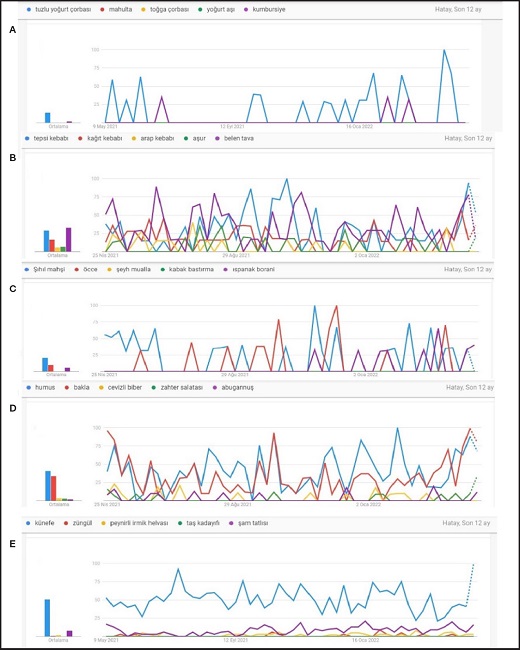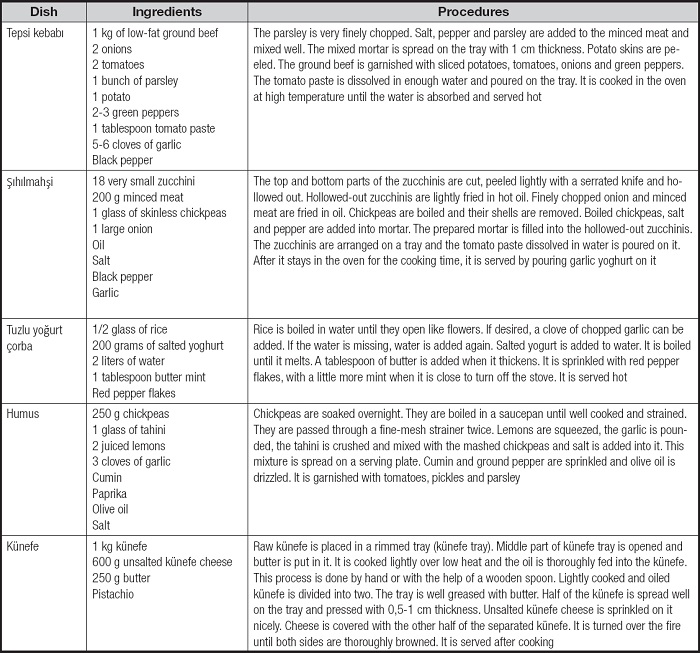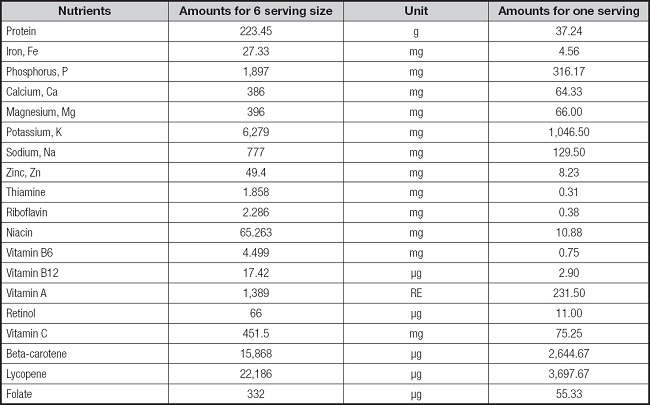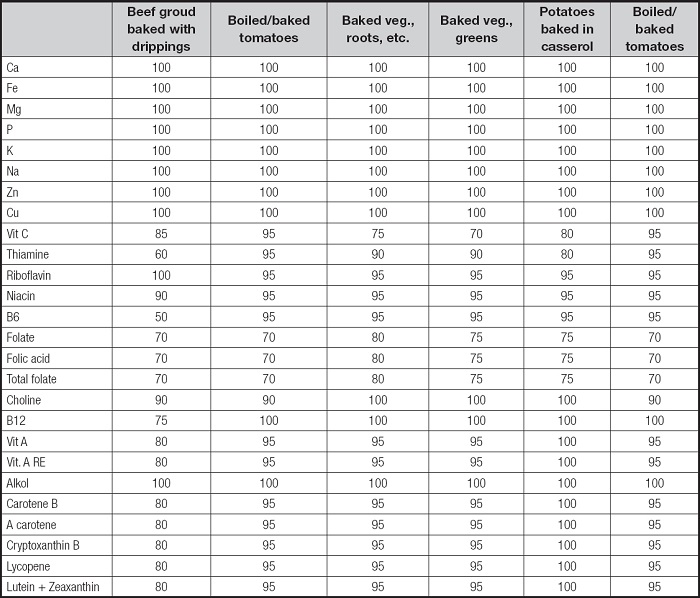INTRODUCTION
Food is a main necessity for all living beings and eating habits differ between cultures throughout history of humankind. Gastronomy investigates the relationship between culture and food and it is known as both science and art related to eating and drinking. Gastronomic values, food and nutrition culture of nations are closely connected to each other (1). Cuisine is a way of meeting the nutritional needs that are essential for human life. Turkish cuisine has an important place among world cuisines with its diversity and richness, because of both different geographical and climatic characteristics and its hosting different ethnic groups. Turkish cuisine has witnessed a process which has been shaped by the history, starting from the nomadic life in the Central Asian Period extending to the Seljuks, the Ottoman Empire and the Republic period (2). The variety of products in Central Asia and Anatolia, cultural interactions in the historical process, and the Seljuk and Ottoman palace cuisines have created the Turkish culinary culture. In general, it consists of juicy dishes prepared with cereals, vegetables and meat, soups, olive oil dishes, pastries and herbs and unique healthy products such as yogurt, bulgur and molasses. Blanching, boiling, simmering, shallow frying, deep frying, grilling and baking are common cooking techniques in Turkish cuisine (3).
Hatay cuisine has an important place in both Turkish cuisine and world cuisine in terms of its multicultural and gastronomic identity shaped by 13 world civilizations (4). The different religions, ethnicities and beliefs of the people diversified the dishes of the region. That is why Hatay cuisine reflects the combination of different civilizations which have lived together for centuries (5). The fact that the region was on main trade roads such as the Silk Road and the Spice Road, connecting Mesopotamia and Central Asia, and the coexistence of different ethnic groups and religions for centuries has created a rich culinary culture. Hatay and its cuisine obtained the title of gastronomy city as part of UNESCO Creative Cities Network (UCCN) in 2017 (6).
Due to the geographic position of the city, Hatay cuisine has some similarities with the Middle Eastern and Anatolian cuisine while maintaining its unique characteristics. Hatay cuisine consists of meat dishes, stuffed vegetables, vegetable dishes, jams, pickles, pilafs, soups, appetizers and salads, herbs collected from nature, desserts, pastries, dairy products and dry foods. In the meantime, spices are one of the most important distinguishing features of Hatay cuisine (7).
The culinary processes differing in cultures alter nutrient value of foods. According to the cooking method and type of food, loss of nutritional components occurs in different levels. The processes such as boiling, cooking, frying, microwaving and leaching into water can be the reason of nutrient losses (8). In order to perform a correct estimation of nutrient intake, it is important to calculate nutritional retention determining true nutritional information of foods (9). The aim of this study is analyzing the retention in some traditional dishes in Hatay cuisine: tepsi kebabı, şıhılmahşi, tuzlu yoğurt çorba, humus and künefe.
MATERIALS AND METHODS
Google Trends is an open access tool that allows to determine the popularity of search terms or topics searched by Google users in a specific area and time period. The tool provides an index of relative search volume ranged between 0 and 100. If the relative search volume for a term is 100, that means it is the most searched term in a particular period and area; 0 represents no or insufficient search for a term. The keywords can be analyzed in different languages and a maximum of five keywords can be compared at the same time through Google Trends (10).
In the current study, the most common dishes searched in the last 12 months by individuals living in Hatay province were selected. In this context, five main titles were chosen based on the Hatay Culinary Culture and Food book published by the Hatay governorship and all dish names in each title were searched. We have analyzed one of the meat dishes, vegetable dishes, soups, appetizers and desserts from traditional dishes of Hatay cuisine. The search was performed in Turkish language, Hatay was selected as the search region and we used the Google Trends data from May 2021 to April 2022. According to our analysis, it was found that tuzlu yoğurt çorbası, tepsi kebabı, şıhılmahşi, humus and künefe had the highest search volume among the dish types.
The selected dishes contain meat, vegetables, grains, lentils and dairy products in different levels. The nutrients of the dishes are mentioned in table I, calculated according to the cooking methods according to the United States Department of Agriculture (USDA) Nutrient Retention Factor Table. Two hundred and ninety nutrients were evaluated in the table. This evaluation was based on different cooking methods such as boiling, frying, baking, reheating, etc. Initially, uncooked food contents were obtained using the Turkish National Food Composition Database (TürKomp) according to the recipes in table I. Nutrient losses were evaluated via USDA retention factor table. Uncooked nutrient values obtained from TürKomp and retention factor of the food with the highest loss were multiplied with each other. For instance, when the loss of vitamin C in a meal needs to be calculated, firstly it is necessary to calculate which food in the recipe has the lowest retention factor. Then, the level of vitamin C in the food is multiplied according to the retention factors of that food, and the level of vitamin C remaining after cooking is determined (11,12).
When tepsi kebabı was considered to calculate retention factors, firstly, uncooked nutritional contents of the dish was obtained using the Turkish National Food Composition Database, and divided to the number of portion get one serving size of the dish (Table II). After that, ingredients and cooking methods of tepsi kebabı were mentioned and loss of nutrients was evaluated according to the retention factors in the USDA retention factor table (Table III). Meat had the highest nutritional loss, which means its retention factors multiplied with nutritional values of tepsi kebabı. Lastly, the nutritional values of tepsi kebabı obtained from TürKomp and the retention factors of the food ingredient that has the highest loss were multiplied with each other (Table IV).
RESULTS
According to our analysis, it was found that tuzlu yoğurt çorbası had the highest search volume among the soup types served in Hatay cuisine (Fig. 1A), tepsi kebabı had the highest search volume among meat dishes (Fig. 1B), şıhılmahşi among vegetable dishes (Fig. 1C) and hummus among appetizers (Fig. 1D). Lastly, künefe had the highest search volume among the desserts in Hatay cuisine (Fig. 1E).

Figure 1. The most common searches of Hatay local dishes on the web. A. tuzlu yoğurt çorbası had the highest search volume among the soup types served in Hatay cuisine. B. Tepsi kebabı had the highest search volume among meat dishes. C. Şıhılmahşi showed the highest search volume among vegetable dishes. D. Hummus had the highest search volume among appetizers. E. Lastly, künefe had the highest search volume among the desserts in Hatay cuisine. Hatay, Turkey. Data source: Google Trends.
As shown in table V, retention of nutrients in şıhılmahşi, tepsi kebabı, tuzlu yoğurt çorbası, humus and künefe were listed.
ŞIHILMAHŞI
In şıhılmahşi the highest loss was in folate, with 40 %. Folate decreased from 15,33 mcg to 9,2 mcg. Loss of vitamin C and thiamine were 35 %, while loss of niacin and vitamin B6 were 30 %. Vitamin C decreased from 25.8 to 16.81 mg, thiamine from 0.32 to 0.205 mg, niacin from 3.85 to 2.693 mg, and B6 from 0.43 to 0.298 mg. There was a 25 % loss of vitamin B12, potassium and riboflavin, and 20 % loss of magnesium. Potassium decreased from 952 to 714 mg, magnesium from 88.5 to 70.8 mg, and vitamin B12 from 3,48 mcg to 2,61 mcg. Loss of iron, phosphorus, calcium, sodium, zinc, vitamin A and beta carotene percentages ranged from 10 to 15 %.
TEPSI KEBABI
In tepsi kebabı, the highest loss appeared in vitamin B6, with 50 %. Vitamin B6 decreased from 0,75 mg to 0,37 mg. A 40 % loss occurred in both thiamine and riboflavin. Thiamine decreased from 0,31 mg to 0,19 mg, and riboflavin from 0,38 mg to 0,23 mg. Folate loss was 30 % while B12 loss was 25 %. Folate decreased from 55,33 mcg to 38,73 mcg, and B12 decreased from 2,90 mcg to 2,18 mcg. Vitamin A, retinol, lycopene and beta-carotene loss were 20 %. Vitamin A decreased from 231,5 RE to 185,2 RE. Vitamin C decreased from 75,25 mg to 63,96 mg with, a 15 % loss. Niacin decreased from 10,88 mg to 9,79 mg, with a 10 % loss.
TUZLU YOĞURT ÇORBASI
In tuzlu yoğurt soup, a 70 % loss of B12, 45 % loss of B6 and 40 % loss of thiamine were reported. B12 decreased from 30 mcg to 0,089 mcg, B6 from 0,02 mg to 0,01 mg, and thiamine from 0,07 mg to 0,04 mg.
HUMUS
Considering the nutrient losses of hummus, it was observed that the highest loss was in folate at the level of 40 %. While the amount of folate was 13.3 mcg before cooking, it decreased to 7.4 mcg after cooking. Following this, there was a 35 % loss in thiamine and vitamin C levels. The same degree of loss (15 %) was observed in minerals such as iron, phosphorus, calcium, magnesium, potassium, sodium and zinc.
DISCUSSION
In general, more than one cooking method is applied to local dishes. Overall differences in the retention of nutrients between cooking methods could be used to determine which method of cooking favored best nutrient retention. Retention in meat, legumes, dairy, vegetable and cereals were compared as main food groups in famous Hatay dishes. The different cooking methods alter the biological value of dishes.
Red meat is a common ingredient in many dishes in Hatay cuisine such as tepsi kebabı and şıhılmahşi. Lean red meat is an excellent source of protein, niacin, vitamin B6, vitamin B12, phosphorus, zinc and iron. Protein in red meat contains all essential aminoacids and has a high digestibility compared to beans and whole wheat. The amount of protein in cooked red meat is 28-36 g/100 g, which is a high biological value (13). All vitamins and minerals, including calcium, sodium, potassium, magnesium and phosphorus, decrease during the cooking of meat. Fat-soluble vitamins such as retinol and alpha-tocopherol are less sensitive to heat than water-soluble vitamins (14). While B vitamins in different meat cuts were found as the most affected nutrients by cooking (15), thiamine showed the highest (70-100 %) loss in a study which cooked meat cuts analyzed (14). In our study, nutrient loss of tepsi kebabı, which has red meat as the main ingredient, was the highest in vitamin B6 (50 %), followed by thiamin (40 %) and riboflavin (40 %).
In şıhılmahşi, not only the meat but also the legume and vegetable content of the dish were related to a wide spectrum of nutrient loss. High loss was reported in folate, vitamin C, thiamine, niacin and vitamin B6 compared to other nutrients. Similarly, in hummus, these micronutrients constitute the highest proportion of losses.
The loss of nutrients is quite high during the frying process of zucchini, which is the pre-cooking method in şıhılmahşi. It can be made healthier by using the boiling method or sous vide technique can be applied with the help of vacuum to prepare it in the oven without contacting with water. The positive results of the sous vide technique, which is a new cooking technique in the world of gastronomy, have been observed in the pre-cooking process of the karnıyarık dish. It is predicted that molecular gastronomy will lead to an increase in the number of experimental studies on this technique, which has become widespread (16).
Soaking is an important process before cooking legumes which removes antinutritional factors such as α-galactosides, phytates and lectins and reduces vitamins and minerals. Presoaking legumes in alkaline solutions such as water results in greater loss of vitamins. Thiamine, riboflavin and niacin content of legumes decreases after the soaking and cooking processes (17).
Legumes are also excellent sources of folate. Cooking and softening of legumes need long time, which lowers nutritional value of this group. Rather than boiling, pressure cooking after soaking is recommended for maximum retention in folate of cooked legumes (18). In our study, in hummus and şıhılmahşi dishes, folate retention amounted to 60 %, supporting the high loss of folate in legumes during cooking processes. Soaking, boiling and baking processes caused nutritional losses depending on cooking time.
Salted yoghurt is a local dairy product made from yoghurt and strained yoghurt in the Hatay region. Yogurt or strained yogurt is thickened by heat treatment and salted for storage up to one year.
Salted yoghurt is rich in calcium, phosphorus and potassium minerals but it has been determined that the filtration process causes losses in minerals, especially phosphorus and potassium (19). In our study, a high loss of vitamin B12 (70 %) was estimated in tuzlu yoğurt çorba, containing salted yoghurt. Loss of vitamin B12 mostly results from leaching into water during the cooking processes. Also, during sterilization, a 20 % loss of B12 in milk can occur (8). In a study, vitamin B12 retention of six different fermented products including yoghurt were analyzed. Levels of vitamin B12 decreased by 40-60 % during manufacture (20). On the other hand, vitamin B6 (45 %) and thiamine (40 %) losses are noteworthy. Since rice and yoghurt are cooked in water, high loss of the vitamin B group is expectable.
Künefe is a dessert special to Hatay province made from tel kadayıf and künefe cheese (a pastry similar to shredded wheat and unsalted dessert cheese) (21). Folate and thiamine losses were reported as the main nutrient losses of the dish. Since there is not a reported retention factor for tel kadayıf and künefe cheese, these ingredients' losses were estimated as a form of wheat product and cheese.
Micronutrient levels of dishes change as a result of different cooking methods and micronutrient content of foods. High losses of vitamin B12, B6, folic acid, thiamine and vitamin C were reported in famous Hatay dishes.
The main vitamin B12 sources are meat, milk, eggs, fish, and shellfish. Meat, especially sheep meat, has higher bioavailability of vitamin B12 (22). According to our study, B12 losses were reported in tepsi kebabı, tuzlu yoğurt çorba and şıhılmahşi. The highest loss was in tuzlu yoğurt çorba. As mentioned above, a high loss of vitamin B12 is likely in fermented products. Milk and dairy products, especially yoghurt and yoghurt-based products such as salted yoghurt, have an important place in Hatay cuisine. Accordingly, retention in dairy products should be taken into account. Dairy products are added to soups, appetizers, salads and other meals. Additionally, dairy products such as salted yoghurt and sürk cheese are widely consumed in breakfast (19). Zahtar, which is an important spice consumed in many dishes in Hatay cuisine, is added to sürk cheese (23).
Grains, pulses, nuts, seeds, potatoes, herbs and spices, meat and meat products and fish are foods rich in vitamin B6 (24). An experimental examination on the retention of vitamin B6 in foods indicated that boiling caused higher loss than sauteing and deep frying. Wet heating was mainly responsible for vitamin B6 losses and retention in dry heating of animal foods was relatively low. Average B6 loss after cooking was calculated as 13 % in daily meals, whereas it increased until 75 % in beef boiled in long time (25). Vitamin B6 loss of chicken meats mostly consumed in Turkey was investigated and ranged between 55 % and 89 % (26). In our study, vitamin B6 retention was 50 % in Tepsi kebabı, 55 % in tuzlu yoğurt çorba and 70 % in şıhılmahşi. Long term cooking of these foods and using more than one cooking method are the main reasons causing vitamin B6 retention decrease.
Consuming the water used for boiling in foods, eating raw foods, using dry heating in a short time and short-term heating, especially for animal foods, are recommended to avoid vitamin B6 loss (25). Vitamin B fortification of meat products can also compensate the loss during cooking. Fortification is achieved by vitamin B1, B6 and B12 since they are vital for the human body (27).
Liver, fortified cereal and other grains, legumes and vegetables, especially leafy greens, are excellent sources of folate. Folate retention depends on the type of food and processing methods (28). Folic acid is highly susceptible to light, air, heat and some pH conditions. Cooking time, temperature, pH and leaching into cooking water causes folate loss (18). Some foods that contain folate were examined and folate retention was reported ranging between 14 % and 99 %. Folate retention of boiled lentil was 43 %. In roasted beef liver, folate retention was 14 %, which is the lowest level in the study (28). Duration and type of cooking of green vegetables decreases folate retention in important levels. While retention in boiled broccoli and spinach was about 50 %, steamed broccoli and spinach and grilled beef did not significantly decrease folate content (29). In tepsi kebabı and künefe, folate retention was 70 %, while it was 60 % in hummus and şıhılmahşi. Retention in hummus and şıhılmahşi was lower because of the legume content of the foods.
Cereals and legumes meet a significant part of the thiamine requirements in diet. Inappropriate preparation and cooking techniques cause loss of thiamine in foods. Adding excess water to foods, draining of cooking water, high temperature, high pH and long cooking time increase the loss of thiamine (30). When thiamine retention is considered, it was assessed that thiamine loss was common in most of the traditional foods. In a study conducted in Japan, the average retention of thiamine in meals was found to be 50-60 %. There was a great loss of thiamine in green vegetables and rice, and it was pointed that boiling results in large losses (31). Consistent with this finding, thiamin retention was around 60-65 % when calculated using USDA. Another study conducted with more than 200 food samples stated that the cooking losses of ascorbic acid, thiamine, riboflavin, beta-carotene and folic acid were 34.6, 30, 52.2, 45.9 and 32.2 %, respectively (32).
Vegetables are rich sources of vitamin C and cooked vegetables have higher vitamin C content than raw ones. Steaming has been stated as the best cooking method to maintain vitamin C content of foods (33). Vitamin C content comes from zucchini in şıhılmahşi, tomatoes in tepsi kebabı and lemon in hummus. Although losses ranged between 15 and 35 were reported, these losses are neglectable because of low amounts of vitamin C.
The calculations related to nutritional loss may overestimate the retention of nutrients. Results of a Korean study indicated that folate intake from cooked dishes could be overestimated in comparison to a microbiological assay after trienzyme extraction. In this study, the calculated values were found higher than the analyzed values (34). It should be noted that data measured by laboratory methods could be more reliable than the calculation. Furthermore, our approach overestimates the losses study because we chose the retention factor of the ingredient with the highest loss. This results in overestimating the losses of some nutrients which take part in the foods with higher retention factors. Therefore, using only the USDA Nutrient Retention Factor Table for retention of nutrients seems like a limitation of the study.
The second limitation of the study is that we used the dishes of only Hatay cuisine and only the specific dishes selected according to their popularity through Google Trends. It could be better if dishes of other regions were analyzed and compared with each other. Thirdly, although we got reliable results by Google Trends, selected dishes might not reflect the nutritional culture of the Hatay cuisine. In a study conducted in South America (35), a questionnaire was used in order to collect recipes of region and a dietary recall for nutritional intake. This might be useful to reflect nutritional intake, but there might be subject bias.
CONCLUSION
In conclusion, cooking methods can cause significant loss of vitamins and minerals in internationally famous Hatay cuisine dishes. Common techniques such as prolonged cooking in water and baking caused mainly vitamin B6, folate, vitamin B12 and thiamine losses. Making local foods in Turkey is quite difficult. Generally, various cooking methods are applied to dishes. Local foods can be made healthier by choosing special cooking, preparation and preservation practices which decrease micronutrient loss. Steaming rather than boiling can be applied when cooking vegetables in order to minimalize the water-soluble vitamins. Likewise, rather than boiling, pressure cooking can be applied when cooking legumes. It is predicted that issues that adversely affect human health such as excessive use of oils would be solved by using different cooking techniques such as sous vide. Cooking methods that adversely affect human health predispose towards diseases such as obesity and cancer. Different cooking techniques should be investigated within the scope of researches that help foods become healthier and increase the rate of individuals benefiting from nutrients.



















